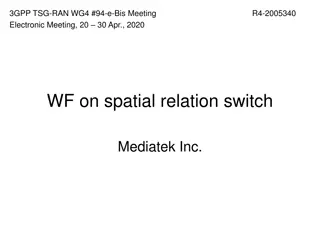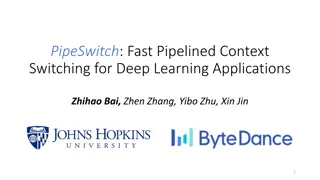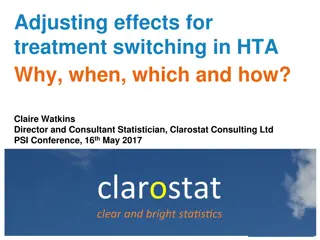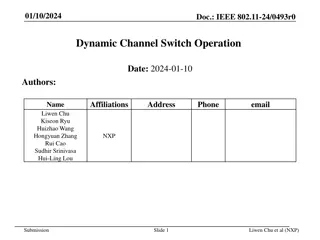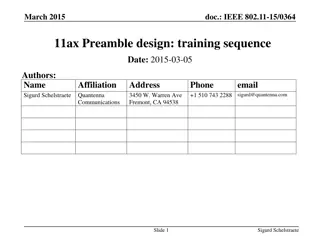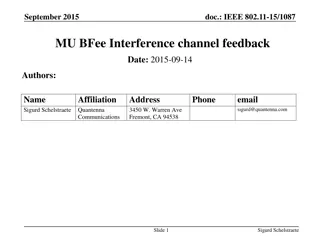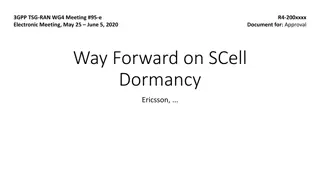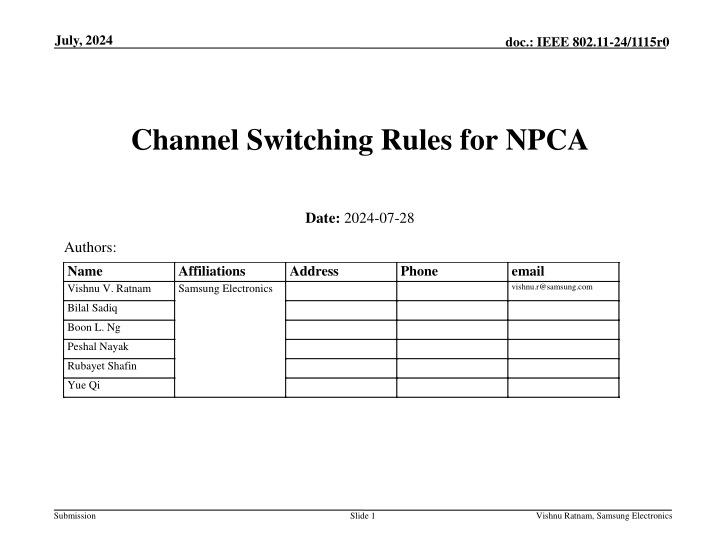
Channel Switching Rules for NPCA in July 2024 Document
This document in July 2024 proposes mechanisms for an AP with NPCA operation enabled and outlines triggering conditions for switching to NPCA backup channels in IEEE 802.11 networks. It explains the non-primary channel access (NPCA) mechanism, scenarios for channel switching, and configurable trigger conditions both for APs and non-AP STAs.
Download Presentation

Please find below an Image/Link to download the presentation.
The content on the website is provided AS IS for your information and personal use only. It may not be sold, licensed, or shared on other websites without obtaining consent from the author. If you encounter any issues during the download, it is possible that the publisher has removed the file from their server.
You are allowed to download the files provided on this website for personal or commercial use, subject to the condition that they are used lawfully. All files are the property of their respective owners.
The content on the website is provided AS IS for your information and personal use only. It may not be sold, licensed, or shared on other websites without obtaining consent from the author.
E N D
Presentation Transcript
July, 2024 doc.: IEEE 802.11-24/1115r0 Channel Switching Rules for NPCA Date: 2024-07-28 Authors: Name Vishnu V. Ratnam Affiliations Samsung Electronics Address Phone email vishnu.r@samsung.com Bilal Sadiq Boon L. Ng Peshal Nayak Rubayet Shafin Yue Qi Submission Slide 1 Vishnu Ratnam, Samsung Electronics
July, 2024 doc.: IEEE 802.11-24/1115r0 Abstract This document proposes mechanisms for an AP with NPCA operation enabled, and an NPCA supporting non-AP STA to indicate the trigger conditions under which the switch to the NPCA backup primary channel (PCH) will be performed. Submission Slide 2 Vishnu Ratnam, Samsung Electronics
July, 2024 doc.: IEEE 802.11-24/1115r0 Non-primary Channel Access - Recap Per baseline, if the primary channel (PCH) is busy due to an OBSS transmission, then no BSS transmissions are possible even if there is a secondary channel that is idle. As a solution, non-primary channel access (NPCA) mechanism has been proposed [1-8]. In NPCA operation, NPCA AP defines an NPCA backup PCH. If an OBSS transmission occupies the PCH of the AP, the AP and associated NPCA supporting non-AP STAs switch to the NPCA backup PCH for frame exchanges. The frame exchanges are performed while treating that backup PCH as the temporary PCH. These exchanges may continue till either: The end of the PPDU duration set by the OBSS transmission on the PCH [6]. We refer to this as PPDU duration based NPCA. The end of the NAV duration set by the OBSS transmission on PCH [1-2]. We refer to this as NAV duration based NPCA. The AP and non-AP STAs return to the PCH at the end of the duration. Submission Slide 3 Vishnu Ratnam, Samsung Electronics
July, 2024 doc.: IEEE 802.11-24/1115r0 NPCA channel switch triggering conditions When the PCH is occupied by a transmission, several conditions may be imposed on the transmission to determine whether it is eligible to trigger the AP and NPCA supporting STAs should perform the switch to the NPCA backup PCH. Such triggering conditions may be of three types: 1. Spec-defined trigger conditions: These include non-configurable conditions imposed by the spec. 2. AP-configurable trigger conditions: These are additional configurable trigger conditions/restrictions imposed by the NPCA AP for its BSS, based on the need. 3. STA-configurable trigger conditions: These conditions/restrictions that are indicated by a non-AP STA and are only applicable to the non-AP STA. The purpose of these configurable trigger conditions can be to accommodate for a variety of deployment scenarios and AP/non-AP STA implementations. are additional configurable trigger Submission Slide 4 Vishnu Ratnam, Samsung Electronics
July, 2024 doc.: IEEE 802.11-24/1115r0 1. Spec defined triggering conditions The spec may define some non-configurable triggering conditions for the NPCA channel switch when a transmission is observed to occupy the PCH of the AP/BSS. Such triggering conditions may include: 1. Requirements on PPDU duration or NAV duration of the PPDU observed on the PCH: If PPDU is in HE+ format and NAV duration + PPDU duration T* > Threshold, or Here NAV is from TXOP subfield. Here T* indicates time of switch determination, T* = PHY header duration. If PPDU is in pre-HE format and NAV duration + PPDU duration T* > Threshold, or Here NAV is from Duration field. Here T* indicates time of switch determination, T* = PPDU duration. If PPDU is in pre-HE format and PPDU duration T* > Threshold. Here T* indicates time of switch determination, T* = PHY header duration + MAC header duration. Note: For pre-HE, can restrict to non-HT/ low MCS cases, for low PER. [TBD] 2. Requirement that the PPDU transmission BW should not overlap with the NPCA backup PCH. If the transmission is in a non-HT duplicate format, bandwidth signaling is required by T* time. Note: For CTS (without RTS observed) may not know if RX parameter CH_BANDWIDTH_IN_NON_HT is valid. 3. Requirements on the TA/RA/BSS Color of PPDU observed on the PCH: The PPDU should be classified as inter-BSS PPDU by T* time. If PPDU is in pre-HE format, neither TA nor RA of the PPDU should match the BSSID of the BSS or any of the other BSSs in the same multiple BSSID set or co-hosted BSSID set to which its BSS belongs or the wildcard BSSID. If the PPDU is in HE+ format, BSS color should not match that of the BSS. Note1: Checking for intra-BSS NAV=0 is not sufficient. Note2: CTS/CTS-to-self may not be classifiable as inter/intra BSS PPDU in some cases. Submission Slide 5 Vishnu Ratnam, Samsung Electronics
July, 2024 doc.: IEEE 802.11-24/1115r0 NPCA Trigger conditions at AP NAV duration based NPCA. Detect preamble on PCH No Yes NAV duration + PPDU duration T* > Thresh. PPDU format = pre-HE PPDU BW non-overlapping with NPCA PCH by T*? PPDU/MAC frame classified as inter-BSS by T*? Check AP configurable Trigger conditions Check MAC frame specific conditions Perform channel switch to Yes NPCA PCH PPDU duration T* > Thresh Yes Yes Yes Yes Yes Yes NAV duration + PPDU duration T* > Thresh. PPDU duration based NPCA. NAV duration based NPCA. Note: The sequence of the rule checks here is for illustration only. The order of checks may be more complex and implementation dependent. Frame-specific conditions may apply for some frames e.g. NAV reset check for RTS frame. Submission Slide 6 Vishnu Ratnam, Samsung Electronics
July, 2024 doc.: IEEE 802.11-24/1115r0 2. AP configurable triggering conditions (1/2) To accommodate a variety of deployment scenarios, AP should be allowed to configure some additional BSS-specific NPCA triggering conditions. The configurable triggering conditions may include an indication of: 1. Unavailability windows, where NPCA will not be used. Unavailability can be due to Co-Ex issues or due to C-RTWT or other multi-AP negotiations with a neighboring AP. 2. Formats of OBSS PPDUs that can be used as NPCA triggers. For example, AP in low capability mode (DPS) may only allow NPCA over NAV set by OBSS non-HT PPDUs. 3. Restrictions on RA/TA or BSS Color of the NAV-setting OBSS PPDUs. This can be to resolve the hidden node issues [8]. 4. Maximum bandwidth of the OBSS PPDU. This can be to ensure that sufficient RUs remain after switch to NPCA backup PCH. 5. Requirement on the RSSI of the OBSS PPDU > Threshold. These conditions may be indicated in an NPCA Control element included by the AP in Beacon, Probe Response, Association Response frames it transmits. The Control element may include a Status field, TBTT Count field, and one or more NPCA Information fields (which carry the trigger condition parameters), as illustrated in the next slide. Submission Slide 7 Vishnu Ratnam, Samsung Electronics
July, 2024 doc.: IEEE 802.11-24/1115r0 2. AP configurable triggering conditions (2/2) These trigger conditions may also be updated by the AP over time. The NPCA Status field may be set to Update to indicate an update of parameters. Two sets of NPCA trigger condition parameter sets may be present, one first one indicating the currently applicable NPCA parameter set and the second one indicating the new NPCA parameters to be applied. The number of beacons after which the new parameters are applicable are indicated in TBTT Count field. The NPCA Control element may also be used to enable/disable NPCA operation by an AP. The NPCA Status field may be set to Enable/Disable. The new NPCA status that will be applicable after a number of beacon intervals, indicated in the TBTT Count field. NPCA Status TBTT Count NPCA Info field 1 NPCA Info field 2 (optional) NPCA PCH NPCA Trigger Conditions Unavailabilit y Windows Max. PPDU version MAC Address List BSS Color List Max. PPDU Bandwidth RSSI Threshold Submission Slide 8 Vishnu Ratnam, Samsung Electronics
July, 2024 doc.: IEEE 802.11-24/1115r0 3. Non-AP configurable triggering conditions (1/2) To accommodate different non-AP implementations, a non-AP STA should be allowed to indicate some additional STA-specific NPCA triggering conditions. The AP shall not expect the NPCA capable STA to be available on the NPCA backup PCH if the STA-specific trigger conditions corresponding to the STA are not satisfied. The configurable triggering conditions may include indication of: 1. Unavailability windows, where NPCA will not be used by the STA. Unavailability can be due to, for example, Co-Ex issues. 2. Formats of NAV-setting OBSS PPDUs that can be used as NPCA triggers. For example, a non-AP STA in EMLSR mode may chose to only perform NPCA switch over OBSS initial control frames. 3. Maximum bandwidth of the OBSS PPDU. This can be to ensure that sufficient RUs remain after switch to NPCA backup PCH. These conditions can be indicated in an NPCA Support Notification frame sent by a non- AP STA to the AP. The same Notification frame can also be used to enable/disable NPCA support. Submission Slide 9 Vishnu Ratnam, Samsung Electronics
July, 2024 doc.: IEEE 802.11-24/1115r0 3. Non-AP configurable triggering conditions (2/2) The indicated trigger conditions may be applicable upon successful transmission of the NPCA Support Notification frame. Order Information 1 Category 2 Protected UHR Action 3 Dialog Token 4 NPCA Support element NPCA Support Status STA-specific NPCA Trigger Conditions Unavailability Windows Max. PPDU version Max. PPDU Bandwidth Submission Slide 10 Vishnu Ratnam, Samsung Electronics
July, 2024 doc.: IEEE 802.11-24/1115r0 NPCA Trigger conditions at non-AP STA NAV duration based NPCA. Detect preamble on PCH No Yes NAV duration + PPDU duration T* > Thresh. PPDU format = pre-HE PPDU BW non-overlapping with NPCA PCH by T*? PPDU/MAC frame classified as inter-BSS by T*? Check AP configurable Trigger conditions Check STA-specific Trigger conditions Check MAC frame specific conditions Perform channel switch to Yes NPCA PCH PPDU duration T* > Thresh Yes Yes Yes Yes Yes Yes Yes NAV duration + PPDU duration T* > Thresh. PPDU duration based NPCA. NAV duration based NPCA. Note: The sequence of the rule checks here is for illustration only. The order of checks may be more complex and implementation dependent. Frame-specific conditions may apply for some frames e.g. NAV reset check for RTS frame. Submission Slide 11 Vishnu Ratnam, Samsung Electronics
July, 2024 doc.: IEEE 802.11-24/1115r0 Conclusion The spec may define requirements on the observed transmissions on the PCH, for triggering NPCA channel switch within the BSS. These requirements may depend on: PPDU duration, NAV duration, Inter-BSS classifiability, PPDU BW determinability, Expected time of NPCA switch determination T*, etc. To allow varied implementations and deployment scenarios, some configurable trigger conditions may be indicated by the AP. To support varied implementations and non-AP STA capabilities, some configurable STA-specific trigger conditions may be indicated by the non-AP STA. Submission Slide 12 Vishnu Ratnam, Samsung Electronics
July, 2024 doc.: IEEE 802.11-24/1115r0 Q and A Q) Why not restrict NPCA trigger conditions to non-HT control frames and HE+ PPDUs? A) Many broadcast management frames, including beacons, and group addressed frames are sent in non-HT format. They consume significant airtime (low MCS) and are usually sent on a 20MHz BW. Thus, they are ideal candidates for NPCA use and should not be ignored. Q) Pre-HE PPDUs don t have NAV indication in the PHY header. NAV duration from MAC header can only be validated after FCS check. So how to use pre-HE PPDUs? A) In the proposal, PPDU duration based NPCA is used for pre-HE OBSS PPDUs if PPDU duration is long. This information is available from L-SIG field in the PHY header. If PPDU duration is short and NAV duration is long (i.e., control frame) then NAV duration based NPCA can be used after the FCS check. Q) MAC header fields are prone to higher PER since they may be sent at a higher MCS. Isn t using them to trigger NPCA switch without FCS check risky? A) In the proposal, only information from MAC header that may be used without FCS check is TA/RA information to determine if PPDU is inter-BSS PPDU, before performing PPDU duration- based NPCA. Even if there is an error in TA/RA reception, the medium will still be occupied for the PPDU duration, thus PPDU duration based NPCA can still be used. Furthermore, this higher PER concern is not applicable for non-HT frames, which are sent at low MCS. L-STF L-LTF L-SIG HT/VHT PHY header MAC header Frame Body FCS Pre-HT PPDU format Submission Slide 13 Vishnu Ratnam, Samsung Electronics
July, 2024 doc.: IEEE 802.11-24/1115r0 Q and A Q) How to abort the reception of a frame after the MAC header when MCS can be variable? A) The PSDU data is forwarded by the PHY to the MAC layer via PHY-DATA.indication(DATA) primitives, each of which sends one octet of information. Thus, the aborting can be done after sufficient number of primitives are received by the MAC, that cover the required fields of the MAC header. Note that this mechanism is agnostic to the MCS used for the frame. Submission Slide 14 Vishnu Ratnam, Samsung Electronics
July, 2024 doc.: IEEE 802.11-24/1115r0 Straw poll 1 In 802.11bn, the event that triggers switching to the NPCA primary channel shall include the detection of an inter-BSS PPDU on the PCH, where PPDU format is (i) non-HT PPDU or (ii) non-HT duplicate PPDU (iii) HE/EHT/UHR PPDU. Note 1: Additional restrictions may be applicable. Note 2: Triggering by HT/VHT PPDUs is TBD. Yes No Abstain Submission Slide 15 Vishnu Ratnam, Samsung Electronics
July, 2024 doc.: IEEE 802.11-24/1115r0 Straw poll 2 Do you agree to allow an NPCA AP to indicate some trigger conditions for performing the NPCA channel switch in the BSS. Yes No Abstain Submission Slide 16 Vishnu Ratnam, Samsung Electronics
July, 2024 doc.: IEEE 802.11-24/1115r0 Straw poll 3 Do you agree to allow an NPCA non-AP STA to indicate some STA- specific trigger conditions for performing the NPCA channel switch. Yes No Abstain Submission Slide 17 Vishnu Ratnam, Samsung Electronics
July, 2024 doc.: IEEE 802.11-24/1115r0 References 1. 2. 3. 4. 5. 6. 7. 8. 11-23/1288r0 Non-primary channel utilization - follow-up (Sindhu Verma, Broadcom) 11-23/2005r1 Non-primary channel access (NPCA) (Minyoung Park, Intel) 11-24/0070r2 Some details about non-primary channel access (Yunbo Li, Huawei) 11-24/0426r0 EDCA for Non-Primary Channel Access (Dongju Cha, LGE) 11-24/0427r0 Enabling Non-Primary Channel Access (Dongju Cha, LGE) 11-24/0458r2 Considerations on Non-Primary Channel Access (Salvatore Talarico, Sony) 11-24/0496r1 Secondary Channel Usage Follow Up (Liwen Chu, NXP) 11-24/0498r0 Non-Primary Channel Access (NPCA) Follow Up (Minyoung Park, Intel) Submission Slide 18 Vishnu Ratnam, Samsung Electronics
July, 2024 doc.: IEEE 802.11-24/1115r0 Backup slides Submission Slide 19 Vishnu Ratnam, Samsung Electronics





